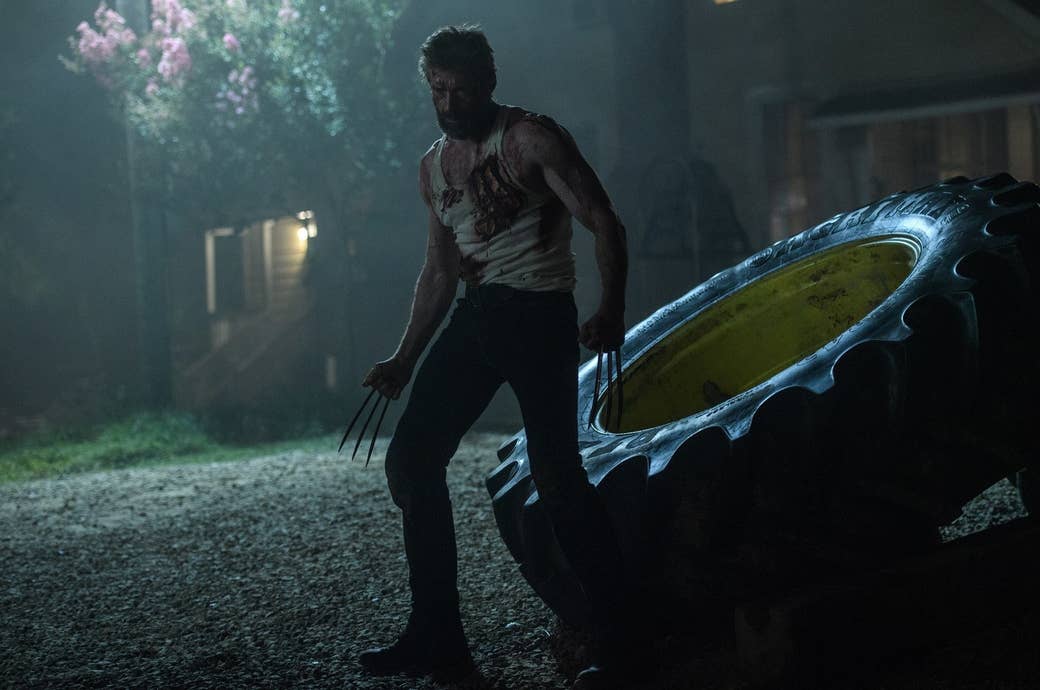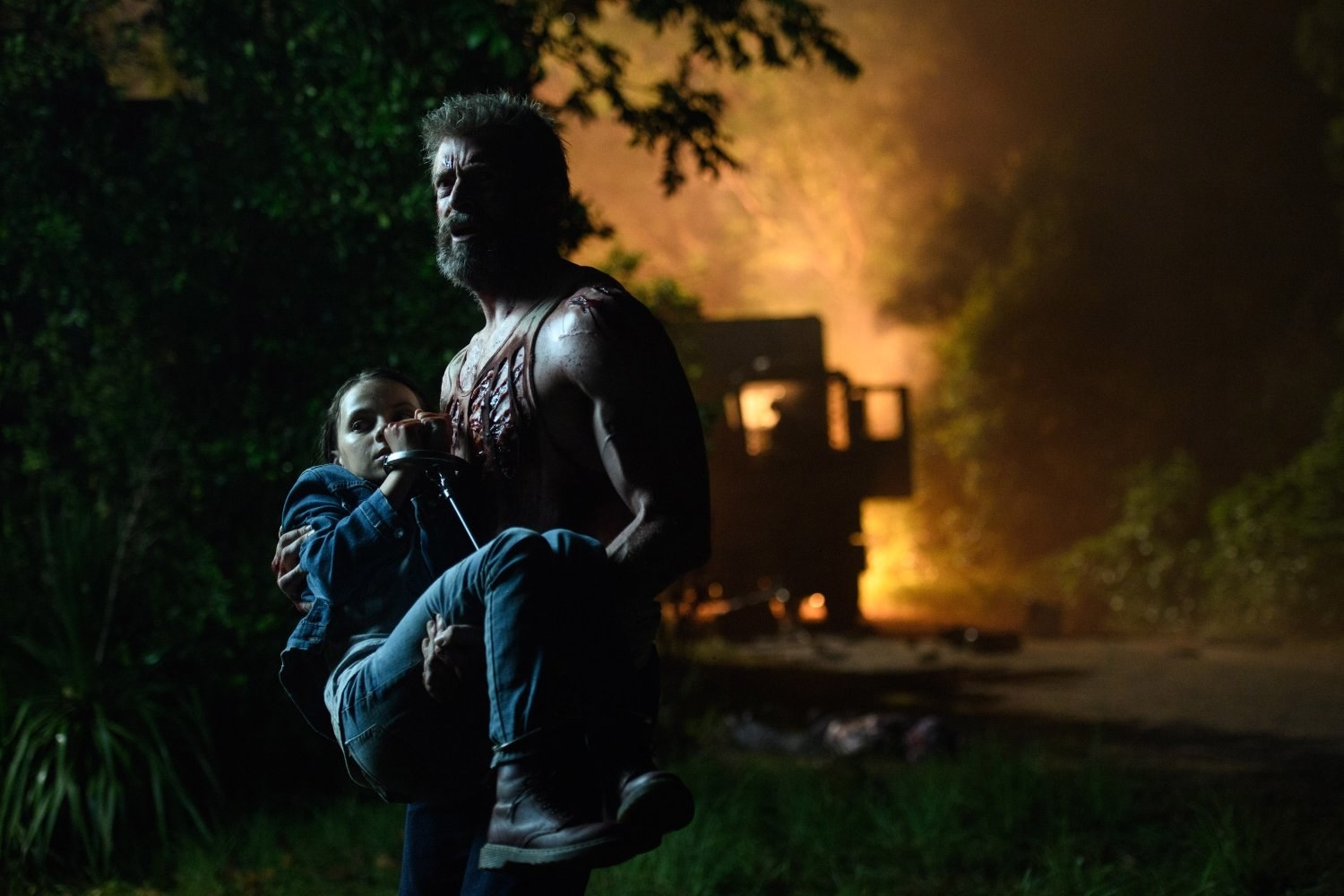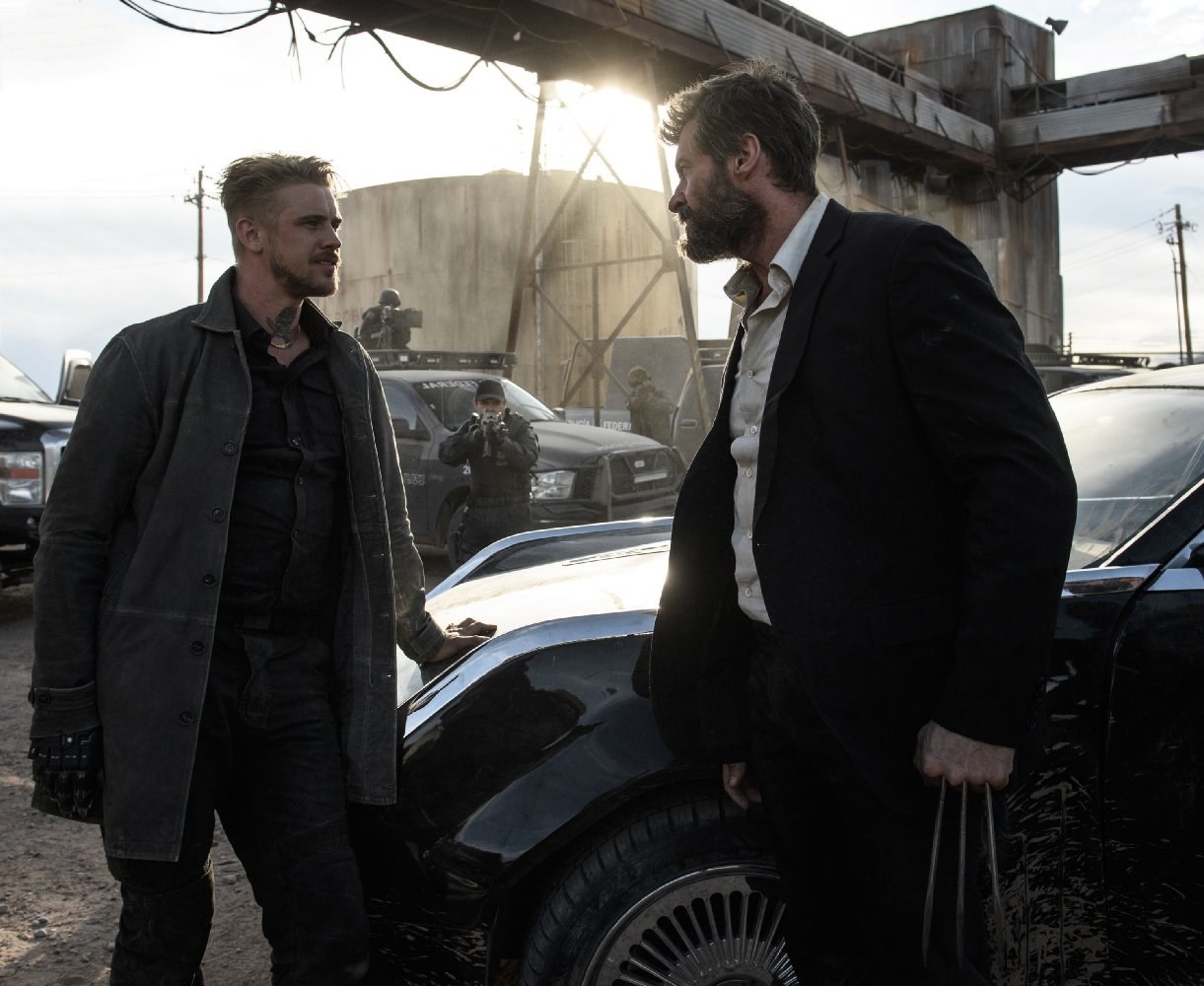
Logan starts with a fight, because fighting is what its title character, even gray-haired and grizzled, is famous for. Other X-Men might be possessed with the ability to read minds or to shapeshift or to control the weather, but Logan (alias Wolverine, alias James Howlett) was conceived with more straightforward ends. He’s equipped with adamantium claws, an indestructible skeleton, and accelerated healing, all the better to dole out and endure pain. He’s built to fight.
Hugh Jackman has played Logan in some capacity in nine X-Men movies now, and the character comes out swinging in most of them. So there’s nothing unexpected about the fact that he does the same at the start of Logan: He wakes up to find a group of men attempting to steal the tires off the vehicle he’s been sleeping in. What is surprising, however, is that when he rams his claws through one guy’s skull, there's a spray of carnage, a juicy, smashed-pumpkin thunk of organic matter giving way to sharpened metal. It’s a moment as disorienting as leaving a bar after a long night to wince at the discovery that the sun is up. Logan has killed dozens and dozens of people over the erratic highs and lows of the X-Men films, but it's never been shown like that, never in a way that actually demanded we feel it.
Logan, which director James Mangold wrote with Scott Frank and Michael Green, is a bruisingly good elegy for the version of Wolverine that Jackman has played for 17 years and is finally retiring. But it’s more than that — it’s a meditation on the way violence has been portrayed in the franchise, and in the larger superhero genre it’s part of. Logan, the lovably gruff, cigar-chomping through line of the X-Men films, has become over the years a flagship representative of the video-game-with-the-gore-turned-off sensibility that keeps things PG-13 — one in which an infinite number of deaths can be racked up so long as the fleshy results of the slaughter aren’t shown.
It’s an unendingly strange compromise the powers that be in Hollywood have arrived at, that brutality is safe for wide consumption so long as its explicit repercussions are elided. What better symbol has there been for that concession than Logan, who has sliced and stabbed his way through battalions of characters with relentless kickassery, but is inevitably the only one who is shown bleeding, since his wounds quickly shrink shut? Logan can’t be permanently hurt and might be able to live forever, the embodiment of consequence-free force who in this new movie suddenly and abruptly is surrounded by consequences after all. When limbs get lopped off and torsos get eviscerated, it doesn’t feel like spectacle, it feels like an unveiling of the butchery that was there all along. Logan plays like the films that came before it are a dream the characters recently woke from.
And in the movie, every bill has come due. It’s set in a 2029 America in which every beloved figure from the past is dead or dying — including Logan himself, who’s not healing the way he used to, and who drinks away the pain between stints driving a limo in El Paso, trying to make enough money to buy a boat and make an escape. Logan’s near future is one in which corporations have the run of the land, vast stretches of genetically engineered corn are tended to by lumbering machinery and gun-toting goons on one side of the border while illegal experiments are fueled with the callously discarded bodies of Mexican women on the other. All that’s left for the movie’s new characters is to flee.
Logan has the ailing, ninetysomething Charles Xavier (Patrick Stewart) tucked away across the border in the care of a sun-sensitive fellow mutant named Caliban (Stephen Merchant). The trio are, at least, no longer hunted down as boogeymen. For reasons no one can figure out, no new mutants have been born for over two decades, and as if in the aftermath of a war, the world has moved on to other concerns.

That isn’t to say that mutants can’t be made, though, which is where the young, selectively mute Laura (Dafne Keen) and her frantic caretaker Gabriela (Elizabeth Rodriguez) come in, with a drawling, robot-armed mercenary named Pierce (Boyd Holbrook, who's unanticipatedly fun) on their tail. Laura, who soon ends up in Logan’s reluctant custody, comes packing some familiar abilities and even more familiar sharp accessories, revealed in the film’s best action scene, a fight that deftly teases out anticipation with stretches of silence. Laura’s clashes with the armed men, when they come, are startling in their ferocity and how full-throatedly they enlist a child (Keen, with her young-old face and feral energy, is an incredibly compelling find). Laura shrieks as she guts people, like a kid in the midst of a tantrum, but also like an animal battling for survival.
She is trying with all her might to survive, while Logan is doing some serious consideration of dying, and the thrilling-disturbing extremity of the slaughter that underscores their journey legitimately ups the stakes. Logan has a touch of the Western to it, and directly cites the 1953 classic Shane, which, like Logan, is about the friendship between a child and a man who’s lived as a killer, and who yearns for peace without seeing a way to find it. Except Laura’s no goggle-eyed innocent, and in Logan, there’s never a hope of putting violence in the past. It’s a fact of their lives that they’re resigned to, carried around by the characters like an infection that can be passed along to anyone, friend or foe.
In Logan, it’s not the West that’s over — it’s America. The grimness of the film's near future isn’t the self-parodic gritty variety of comic book adaptations stretching for heft. It’s resonant, all too reasonable, and earned. Its characters, the majority of whom are people of color, deal with a slow slide into apocalypse that has nothing to do with supervillains and their pillars of light and everything to do with the world getting systematically worse.

And that isn’t something you can fight with sharpened claws. Logan and Laura don’t even try, all the havoc they wreak throughout the movie done only in the name of getting away. This is true even in the climactic battle, which is Logan’s most underwhelming sequence, maybe because its story didn't demand a moment like that at all. Climactic battles imply closure by way of defeating an enemy and setting the universe aright. In Logan, nothing will set the universe aright, not all the fighting in the world. Its violence smarts not just because of how graphic and ugly it is, but because it feels like something inextricable from daily existence — something that can’t be left behind, no matter how much its characters would like to. Logan succeeds in something the genre it’s a part of has had little interest in — in making a capacity for violence feel like a loss its characters suffer. In doing so, it gives Wolverine something it seemed like he’d never get — a fitting ending.
